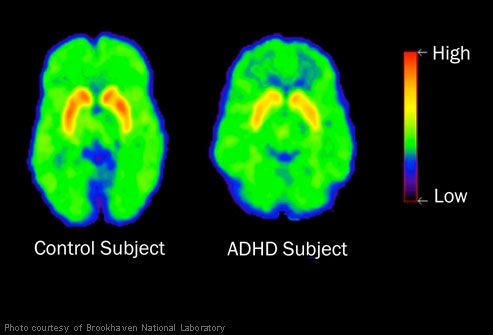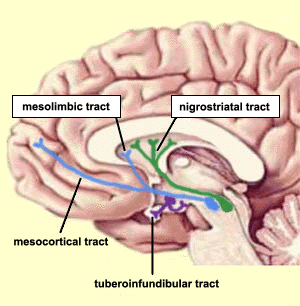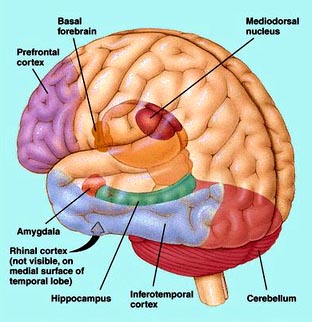
Through a technique known as "diffusion tensor imaging" (DTI), scientists have been able to examine the brains of children with and without a diagnosis of ADHD (Brain Differences in ADHD) [5]. They found several differences, most notably, in the volume of white matter connecting together the frontal cortex, basal ganglia, brainstem, and cerebellum. These areas are involved in higher level thought and reasoning, attention, impulsive behaviour, inhibition, and motor activity. Never-medicated ADHD children had noticeably smaller volume of white matter in these areas, compared to normal children or to ADHD children who had been treated with medications such as Ritalin.
 White matter consists of a massively interconnected network of nerve fibers, each of which is coated with a fatty myelin sheath that keeps the message insulated (i.e, keeps the signal strong) and greatly increases the transmission speed. In order to focus attention, the brain releases the hormone dopamine from centers in the midbrain, and dopamine receptors transmit signals over long distance pathways to the frontal cortex, the basal ganglia, and the cerebellum, as shown in the figure on the left. Dopamine is a crucial hormone that orchestrates the brain's thought processes involved in maintaining attention to a task and subsequently acquiring new knowledge. Defective dopamine utilization is widely suspected to play a role in ADHD [36]. Poor quality white matter on these long-distance connections, as a consequence of insufficient supply of fat from the blood, would have a huge impact on the ability to pay attention and to learn new facts.
White matter consists of a massively interconnected network of nerve fibers, each of which is coated with a fatty myelin sheath that keeps the message insulated (i.e, keeps the signal strong) and greatly increases the transmission speed. In order to focus attention, the brain releases the hormone dopamine from centers in the midbrain, and dopamine receptors transmit signals over long distance pathways to the frontal cortex, the basal ganglia, and the cerebellum, as shown in the figure on the left. Dopamine is a crucial hormone that orchestrates the brain's thought processes involved in maintaining attention to a task and subsequently acquiring new knowledge. Defective dopamine utilization is widely suspected to play a role in ADHD [36]. Poor quality white matter on these long-distance connections, as a consequence of insufficient supply of fat from the blood, would have a huge impact on the ability to pay attention and to learn new facts.  A very exciting research direction that has been undertaken recently addresses the question of the rate of maturation of the brain [31]. 223 children with ADHD were compared with 223 non-ADHD controls. The research utilized magnetic resonance scans to estimate the thickness of the cerebral cortex at more than 40,000 sample points at different positions along the brain surface. Typically, the thickness increases during childhood and then decreases during adolescence. From samples taken over a period of several years, researchers can pinpoint the point in time when the cortex is thickest. The results of the experiments were remarkable: children with ADHD reached peak thickness much later (on average at 10 and a half years old) than children without ADHD (on average at 7 and a half years old). The biggest delay showed up in regions of the prefrontal cortex (shown in the figure on the right) that control attention and motor planning.
A very exciting research direction that has been undertaken recently addresses the question of the rate of maturation of the brain [31]. 223 children with ADHD were compared with 223 non-ADHD controls. The research utilized magnetic resonance scans to estimate the thickness of the cerebral cortex at more than 40,000 sample points at different positions along the brain surface. Typically, the thickness increases during childhood and then decreases during adolescence. From samples taken over a period of several years, researchers can pinpoint the point in time when the cortex is thickest. The results of the experiments were remarkable: children with ADHD reached peak thickness much later (on average at 10 and a half years old) than children without ADHD (on average at 7 and a half years old). The biggest delay showed up in regions of the prefrontal cortex (shown in the figure on the right) that control attention and motor planning. Such a delay in maturation would be a good conservation strategy if there is insufficient fat in the diet. By slowing down the growth rate of the cortex, less demand is placed to acquire adequate fat supply, needed to grow additional neurons and myelinated nerve fibers. The body's stunted growth (another characteristic of ADHD children) could even be a side effect of the need to delay the rate of maturation of the brain. Decreasing the concentration of growth hormone would likely affect both the brain and the body, leading to a consistent slowing down of maturation rates across the board.
3 comments:
On my way to my house I was listening to the radio and tuned a radio station about Generic Viagra then they mentioned this blog. I had never heard of cannibalistic behavior of the brain in children. I personally ignored that information but I'm lucky to have read this in order to be watchful with my children and possible brain damage.
Wow impressive, it's a little research that I saw in Generic Viagra labs about how viagra activate many parts of the brain and heart rate, it's very similar to this study the difference would the amount of food that a person could eat.
Informative article. Thank you so much for such a great post. Know about the best blood test centres in Kerala.
Post a Comment